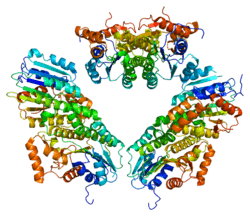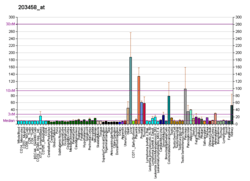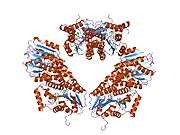Sepiapterin reductase
Sepiapterin reductase is an enzyme that in humans is encoded by the SPR gene.[5][6][7]
Function
Sepiapterin reductase (7,8-dihydrobiopterin:NADP+ oxidoreductase; EC 1.1.1.153) catalyzes the NADPH-dependent reduction of various carbonyl substances, including derivatives of pteridines, and belongs to a group of enzymes called aldo-keto reductases. SPR plays an important role in the biosynthesis of tetrahydrobiopterin.[7]
Reaction
| sepiapterin reductase | |||||||||
|---|---|---|---|---|---|---|---|---|---|
| Identifiers | |||||||||
| EC number | 1.1.1.153 | ||||||||
| Databases | |||||||||
| IntEnz | IntEnz view | ||||||||
| BRENDA | BRENDA entry | ||||||||
| ExPASy | NiceZyme view | ||||||||
| KEGG | KEGG entry | ||||||||
| MetaCyc | metabolic pathway | ||||||||
| PRIAM | profile | ||||||||
| PDB structures | RCSB PDB PDBe PDBsum | ||||||||
| Gene Ontology | AmiGO / QuickGO | ||||||||
| |||||||||
Sepiapterin reductase (SPR) catalyzes the chemical reaction
L-erythro-7,8-dihydrobiopterin + NADP+ sepiapterin + NADPH + H+
Thus, the two substrates of this enzyme are L-erythro-7,8-dihydrobiopterin and NADP+, whereas its three products are sepiapterin, NADPH, and a single hydrogen ion (H+).
This enzyme belongs to the family of oxidoreductases, to be specific, those acting on the CH-OH group of donor with NAD+ or NADP+ as acceptor. The systematic name of this enzyme class is 7,8-dihydrobiopterin:NADP+ oxidoreductase. This enzyme participates in folate biosynthesis.
Clinical significance
Sepiapterin reductase deficiency belongs to the rare diseases. The clinical phenotype can include progressive psychomotor retardation, altered tone, seizures, choreoathetosis, temperature instability, hypersalivation, microcephaly, and irritability. Patients with sepiapterin reductase deficiency also manifest dystonia with diurnal variation, oculogyric crises, tremor, hypersomnolence, oculomotor apraxia, and weakness.[9] Response to treatment is variable and the long-term and functional outcome is unknown. To provide a basis for improving the understanding of the epidemiology, genotype/phenotype correlation and outcome of these diseases their impact on the quality of life of patients, and for evaluating diagnostic and therapeutic strategies a patient registry was established by the noncommercial International Working Group on Neurotransmitter Related Disorders (iNTD).[10]
References
- 1 2 3 GRCh38: Ensembl release 89: ENSG00000116096 - Ensembl, May 2017
- 1 2 3 GRCm38: Ensembl release 89: ENSMUSG00000033735 - Ensembl, May 2017
- ↑ "Human PubMed Reference:".
- ↑ "Mouse PubMed Reference:".
- ↑ Ichinose H, Katoh S, Sueoka T, Titani K, Fujita K, Nagatsu T (Oct 1991). "Cloning and sequencing of cDNA encoding human sepiapterin reductase--an enzyme involved in tetrahydrobiopterin biosynthesis". Biochem Biophys Res Commun. 179 (1): 183–189. doi:10.1016/0006-291X(91)91352-D. PMID 1883349.
- ↑ Persson B, Kallberg Y, Bray JE, Bruford E, Dellaporta SL, Favia AD, Duarte RG, Jornvall H, Kavanagh KL, Kedishvili N, Kisiela M, Maser E, Mindnich R, Orchard S, Penning TM, Thornton JM, Adamski J, Oppermann U (Feb 2009). "The SDR (short-chain dehydrogenase/reductase and related enzymes) nomenclature initiative". Chem Biol Interact. 178 (1–3): 94–98. doi:10.1016/j.cbi.2008.10.040. PMC 2896744. PMID 19027726.
- 1 2 "Entrez Gene: SPR sepiapterin reductase (7,8-dihydrobiopterin:NADP+ oxidoreductase)".
- ↑ http://brenda-enzymes.info/enzyme.php?ecno=1.1.1.153
- ↑ Pearl PL, Taylor JL, Trzcinski S, Sokohl A (May 2007). "The pediatric neurotransmitter disorders". J Child Neurol. 22 (5): 606–616. doi:10.1177/0883073807302619. PMID 17690069.
- ↑ "Patient registry".
Further reading
- Katoh S (1971). "Sepiapterin Reductase from Horse Liver: Purification and Properties of the Enzyme". Arch. Biochem. Biophys. 146 (1): 202–214. doi:10.1016/S0003-9861(71)80057-7. PMID 4401291.
- Matsubara M, Katoh S, Akino M, Kaufman S (1966). "Sepiapterin Reductase". Biochim. Biophys. Acta. 122 (2): 202–212. doi:10.1016/0926-6593(66)90062-2. PMID 5969298.
- Takikawa S, Curtius HC, Redweik U, et al. (1987). "Biosynthesis of tetrahydrobiopterin. Purification and characterization of 6-pyruvoyl-tetrahydropterin synthase from human liver". Eur. J. Biochem. 161 (2): 295–302. doi:10.1111/j.1432-1033.1986.tb10446.x. PMID 3536512.
- Thöny B, Heizmann CW, Mattei MG (1995). "Human GTP-cyclohydrolase I gene and sepiapterin reductase gene map to region 14q21-q22 and 2p14-p12, respectively, by in situ hybridization". Genomics. 26 (1): 168–170. doi:10.1016/0888-7543(95)80101-Q. PMID 7782081.
- Maruyama K, Sugano S (1994). "Oligo-capping: a simple method to replace the cap structure of eukaryotic mRNAs with oligoribonucleotides". Gene. 138 (1–2): 171–174. doi:10.1016/0378-1119(94)90802-8. PMID 8125298.
- Maier J, Schott K, Werner T, et al. (1994). "Northern blot analysis of sepiapterin reductase mRNA in mammalian cell lines and tissues". Adv. Exp. Med. Biol. 338: 195–8. doi:10.1007/978-1-4615-2960-6_39. PMID 8304109.
- Maier J, Schott K, Werner T, et al. (1993). "Detection of a novel sepiapterin reductase mRNA: assay of mRNA in various cells and tissues of various species". Exp. Cell Res. 204 (2): 217–222. doi:10.1006/excr.1993.1027. PMID 8440319.
- Suzuki Y, Yoshitomo-Nakagawa K, Maruyama K, et al. (1997). "Construction and characterization of a full length-enriched and a 5'-end-enriched cDNA library". Gene. 200 (1–2): 149–156. doi:10.1016/S0378-1119(97)00411-3. PMID 9373149.
- Blau N, Thöny B, Renneberg A, et al. (1998). "Dihydropteridine reductase deficiency localized to the central nervous system". J. Inherit. Metab. Dis. 21 (4): 433–434. doi:10.1023/A:1005327313348. PMID 9700606.
- Ohye T, Hori TA, Katoh S, et al. (1998). "Genomic organization and chromosomal localization of the human sepiapterin reductase gene". Biochem. Biophys. Res. Commun. 251 (2): 597–602. doi:10.1006/bbrc.1998.9503. PMID 9792819.
- Blau N, Thöny B, Renneberg A, et al. (1999). "Variant of dihydropteridine reductase deficiency without hyperphenylalaninaemia: effect of oral phenylalanine loading". J. Inherit. Metab. Dis. 22 (3): 216–220. doi:10.1023/A:1005584627797. PMID 10384371.
- Bonafé L, Thöny B, Penzien JM, et al. (2001). "Mutations in the sepiapterin reductase gene cause a novel tetrahydrobiopterin-dependent monoamine-neurotransmitter deficiency without hyperphenylalaninemia". Am. J. Hum. Genet. 69 (2): 269–277. doi:10.1086/321970. PMC 1235302. PMID 11443547.
- Fujimoto K, Takahashi SY, Katoh S (2002). "Mutational analysis of sites in sepiapterin reductase phosphorylated by Ca2+/calmodulin-dependent protein kinase II". Biochim. Biophys. Acta. 1594 (1): 191–8. doi:10.1016/S0167-4838(01)00300-4. PMID 11825621.
- Strausberg RL, Feingold EA, Grouse LH, et al. (2003). "Generation and initial analysis of more than 15,000 full-length human and mouse cDNA sequences". Proc. Natl. Acad. Sci. U.S.A. 99 (26): 16899–16903. doi:10.1073/pnas.242603899. PMC 139241. PMID 12477932.
- Franscini N, Bachli EB, Blau N, et al. (2005). "Functional tetrahydrobiopterin synthesis in human platelets". Circulation. 110 (2): 186–192. doi:10.1161/01.CIR.0000134281.82972.57. PMID 15197144.
- Steinberger D, Blau N, Goriuonov D, et al. (2005). "Heterozygous mutation in 5'-untranslated region of sepiapterin reductase gene (SPR) in a patient with dopa-responsive dystonia". Neurogenetics. 5 (3): 187–190. doi:10.1007/s10048-004-0182-3. PMID 15241655.
- Gerhard DS, Wagner L, Feingold EA, et al. (2004). "The status, quality, and expansion of the NIH full-length cDNA project: the Mammalian Gene Collection (MGC)". Genome Res. 14 (10B): 2121–2127. doi:10.1101/gr.2596504. PMC 528928. PMID 15489334.
- Sharma M, Mueller JC, Zimprich A, et al. (2006). "The sepiapterin reductase gene region reveals association in the PARK3 locus: analysis of familial and sporadic Parkinson's disease in European populations". J. Med. Genet. 43 (7): 557–562. doi:10.1136/jmg.2005.039149. PMC 2593029. PMID 16443856.
- Farrugia R, Scerri CA, Montalto SA, et al. (2007). "Molecular genetics of tetrahydrobiopterin (BH4) deficiency in the Maltese population". Mol. Genet. Metab. 90 (3): 277–283. doi:10.1016/j.ymgme.2006.10.013. PMID 17188538.
- Tobin JE, Cui J, Wilk JB, et al. (2007). "Sepiapterin reductase expression is increased in Parkinson's disease brain tissue". Brain Res. 1139: 42–47. doi:10.1016/j.brainres.2007.01.001. PMC 1868471. PMID 17270157.






